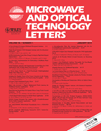5.8 GHz full duplex amplitude shift keying retrodirective interrogator array
Abstract
This article describes a practical demonstration of a complete full-duplex “amplitude shift keying (ASK)” retrodirective radio frequency identification (RFID) transceiver array.The interrogator incorporates a “retrodirective array (RDA)” with a dual-conversion phase conjugating architecture in order to achieve better performance than is possible with conventional RFID solutions. Here mixers phase conjugate the incoming signal and a carrier recovery circuit recovers incoming angle of arrival phase information of an encoded amplitude shift keyed signal. The resulting interrogator provides a receiver sensitivity level of −109 dBm. A four element square patch RDA gives a 3 dB automatic beam steering angle of acceptance of ±45°. When compared to an RFID system operating by conventional (non-retrodirective) means retrodirective action leads to improved range extension of up to 16 times at ±45°. Operator pointing accuracy requirements are also reduced due to automatic retrodirective self-pointing. These features significantly enhance deployment opportunities requiring long range low equivalent isotropic radiation power (EIRP) and/or RFID tagging of moving platforms. © 2012 Wiley Periodicals, Inc. Microwave Opt Technol Lett 55:160–164, 2013; View this article online at wileyonlinelibrary.com. DOI 10.1002/mop.27258




